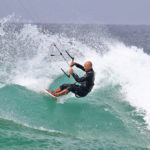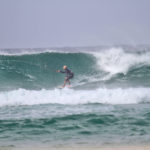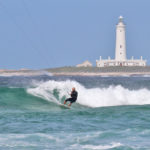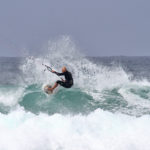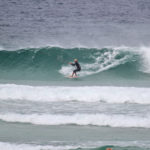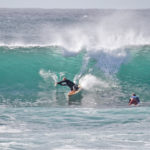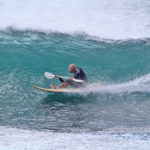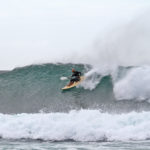
I spent last Week End in Cape St Francis. For those who don’t know, it is famous for it’s wave, (and yes I did dust the old Waveski and got a few good rides in ). So if you ain’t scoring wind, you got the option of an awesome wave with friendly locals as long as you respect their spot and play according to the rules (Not all visitors seem to understand that)
I was on a mission to kite it, to see how the wind was on the South Westerly direction knowing it would be pretty off shore.
Riding real waves in those conditions  is challenging for a few reasons:
Firstly the wind is invariably gusty as it comes over land.
Secondly the timing and way of rinding the wave has to adapt to deal with the wind direction and where the kite sits in the window whilst on the wave.
The first day I went further down around the bay where the wind is a more friendly cross off shore to a spot called “Ducks”. The waves break on sandbanks and are pretty fast and gnarly. You also got some rip currents which can create chop on the wave. The wind as expected, was gusty but manageable for an experienced rider. The close outs did catch me a few times, but I also got some nice runs and turns. The beautiful backdrop of the Cape St Francis lighthouse makes for a good picture.
On the Sunday, with the wind still around, I tried seals point where it is totally off shore.  I realised that my board was lacking a little bit of volume to get me through the dead spots in the wind, so if I’d had the choice, I would have used a board with a little more volume. My Peter Lynn Kiteboarding “Swell” handled nicely as it has great drifting capabilities, I think without a good drifting kite, I would have battled in those off shore conditions. Another observation is that when the wind drops on you, you need to be able towork the kite to generate power. A quick and responsive kite definitely helps.
My Peter Lynn Kiteboarding “Swell” handled nicely as it has great drifting capabilities, I think without a good drifting kite, I would have battled in those off shore conditions. Another observation is that when the wind drops on you, you need to be able towork the kite to generate power. A quick and responsive kite definitely helps.
It was amazing to be riding such clean waves, but challenging to time the turns on the beach break. You almost need to turn a little late to catch the lip coming down so you stay on the wave.
The spot is also a little daunting because of dealing with off shore conditions, and I definitely only recommend it to very experienced kiters with the option of a rescue craft should things go wrong. (I had someone with a JetSki on standby)
During the Week End I came to these conclusions:
- A slightly more buoyant board is an advantage as it allows you to surf the wave through the luls.
- You need a kite that drifts nicely and is super stable even when depowered.
- The timing of your bottom and top turns needs to adapt with the off shore wind so as to connect the lip of the wave.
- Kite placement and anticipation is super important otherwise it wants to pull you over the wave.
- Riding forehand (facing the wave) is a serious advantage to hold the power of the kite.
I Look forward to some more session there.
Thanks Manuela Borsato for the pics.

